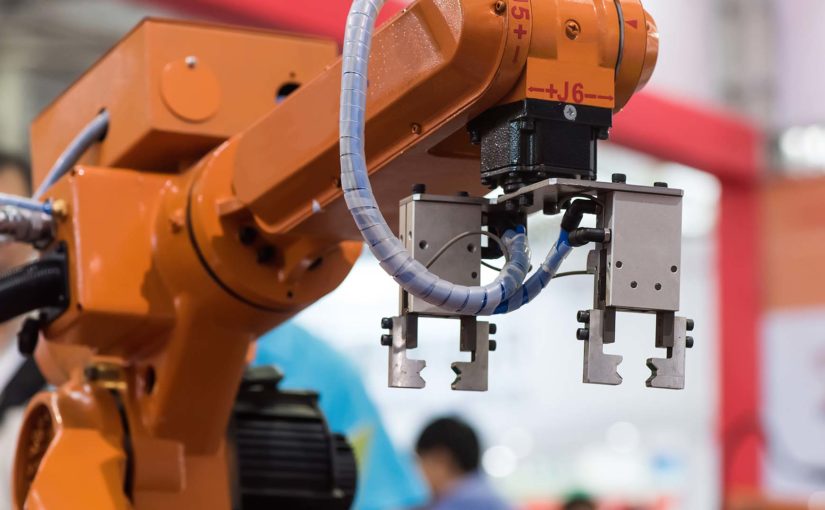New technologies and innovation transform industries each and every day. This is especially true for manufacturers and welders who are consistently looking for advancements and efficiencies in the workplace. These advancements help to improve operations and streamline processes, allowing them to work faster and smarter. For many fields and especially in this case, manufacturing and metal fabrication, one area of technological advancement with the potential to transform the industry is with collaborative robots – commonly known as “cobots.”
A cobot is a type of robot designed to work hand in hand with human beings in a shared physical space. According to BIS Research, the cobot market accounted for a value of over $280 million in 2017 and is expected to grow over the next five years. Bill Pharmer, National Sales Leader of Advanced Fabrication Technologies at Airgas, believes that trained cobots could afford welders more time and attention to grow in their positions and focus on larger projects while the cobot handles the smaller steps that need to be completed.
Cobots and welders in the workplace
Invented in 1999 by Ed Colgate and Michael Peskin, two professors of mechanical engineering at Northwestern University, cobots have paved the way for efficiency and safety in the workplace across several trades. With safety in mind, cobots could create a safer work environment for welders on the floor and in the shop by doing specific tasks that can be strenuous, tedious or pose danger, such as lifting, repetitive motion and handling hazardous materials.
Other safety highlights of a cobot include:
- Cobots can detect movement. If a worker gets in the way, the cobotic arm will slow down or stop moving immediately.
- Some cobots have display screens to let human counterparts know what tasks and projects it is currently working on and what’s on deck.
Cobots also play a useful role in fulfilling certain tasks to alleviate pressure around the ongoing welder shortage. According to the American Welding Society, the welding profession is expecting a deficit of 200,000 in welders by the year 2020. Skilled welders are historically in high demand; however, by integrating cobots into the welding process, they could help increase productivity by taking on repetitive tasks traditionally performed by the welder. Additionally, when compared to traditional robots, cobots are a more attractive option for a less experienced operator who doesn’t have the technical knowledge to program a robot.
With cobots taking over these tedious and mundane tasks, welders spend more time improving and polishing their own skill sets, which leads to a better end product. It’s a win-win situation for the industry as a whole during this time when skilled welders are in demand.
A welder’s wish list for cobots
As helpful as cobots are, in today’s fast-moving, do-everything-now world, many who work with them often wish they would move just a little bit quicker. A noted flaw of cobotic movements is the speed at which they work on the shop floor. Current work environments for welders prove to be difficult for more advanced activities you might wish to use a cobot for because they simply cannot weld while interacting with a human. With that said, Pharmer explains, “These are the types of roadblocks innovators are evaluating as they work towards creating a more ‘welder-friendly’ cobot.”
But what if cobots could weld?
New cobotic enhancements are on the horizon and top of mind for key industry experts and innovators, with a focus on making the machines more “human-like,” according to Robotics Business Review. Management, specifically, wants to see a definitive return on investment when purchasing such a large piece of equipment. This varies based on how effectively cobots are integrated into a business’s welding operations. If cobot technology were to improve to the point where it could weld, grind, cut and finish, welding shops and fabricators could see a rapid and exponential return on investment.
Remember: There are a few issues that need to be worked out before cobots could ever begin to weld. They include:
- Providing and improving communication between a cobot and a welding power source (i.e., being able to coordinate with features such as touch sense and seam tracking).
- Overcoming safety issues that surround welding and welding equipment. This includes smoke, heat, sharp objects and the physical weight of most jobs in welding.
If cobots eventually can do all of the above, the machines themselves will need to be more robust with stall-force-limiting features and have the ability to perform tasks in harsh, high-temperature welding environments. Pharmer predicts that all robots may eventually be able to work collaboratively with humans within the next decade or two as technology advances in areas such as stall force, Kinetiq Teaching and vision.
On the Horizon
Cobots represent an exciting new time for the metal fabrication and manufacturing industries. Industry experts are conducting research into both the possibilities and limitations of cobotics used in welding applications. While cobots offer a strong menu of tools in which they can assist in all types of manufacturing environments, be on the lookout for even more improvements as the industry looks towards a future where employees and cobots work together to be more productive.
